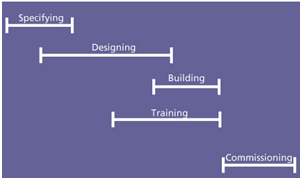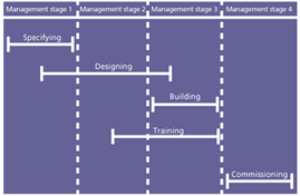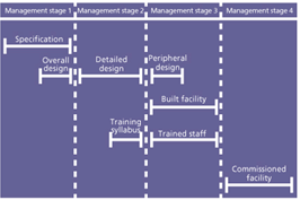PRINCE2 2009 - Progress part 12
of the Cabinet Office under delegated authority from the Controller of HMSO.
The PRINCE2 approach
Use of management stages for control
Technical stages
Another method of grouping work is by the set of techniques used or the products created.
This results in stages covering elements such as design, build and implementation.
Such stages are technical stages and are a separate concept from the management stages already introduced.
Technical stages often overlap (as in diagram 1 and 2) but management stages do not.
Technical stages are typified by the use of a particular set of specialist skills.
Management stages equate to commitment of resources and authority to spend.
Often the boundary of the two types of stage will coincide - for instance, where the management decision is based on the output from the technical stage.
However, on other occasions the stage boundaries will not coincide - for example, there might be more than one technical stage per management stage.
Where a technical stage spans a management stage boundary, the extent to which the product(s) of the technical stage should be complete at the stage boundary should be clear in the Product Description(s) concerned.
Diagram 1
Diagrams 1, 2 and 3 give examples of the distinction between technical and management stages.
Diagram 1 shows a project with five technical stages.
Diagram 2
Diagram 2 shows the same project from diagram 1, but broken down into four management stages.
Two of the technical stages span more than one management stage.
Diagram 3
Diagram 3 shows that the technical stage of ‘designing’ has been broken into three product groups.
The overall design now falls within management stage 1; detailed design and training syllabus form the second management stage; and periphery design is scheduled for management stage 3, together with the creation of the built facility and trained staff.
The PRINCE2® approach is to concentrate the management of the project on the management stages since these will form the basis of the planning and control processes described throughout the method.
To do otherwise runs the risk of the project being driven by the specialist teams instead of the customer’s management.
Under PRINCE2 2009 planning is covered by the Plans theme.
The purpose of the Plans theme is to facilitate communication and control by defining the means of delivering the products (the where and how, by whom, and estimating the when and how much).
Effective project management relies on effective planning as without a plan there is no control.
[see Plans - Purpose]
A Stage Plan is required for each management stage.
The Stage Plan is similar to the Project Plan in content, but each element will be broken down to the level of detail required to be an adequate basis for day-to-day control by the Project Manager.
Each Stage Plan for the next management stage is produced near the end of the current management stage.
[see Plans - Plans defined - Stage Plans]
PRINCE2® is a Registered Trade Mark of the Office of Government Commerce in the United Kingdom and other countries.
Managing Successful Projects with PRINCE2 - 2005 edition
Managing successful Projects with PRINCE2 – 2009 edition
Directing Projects with PRINCE2.
plus:
The Complete Project Management package.
And much more besides - at a fantastic price.







